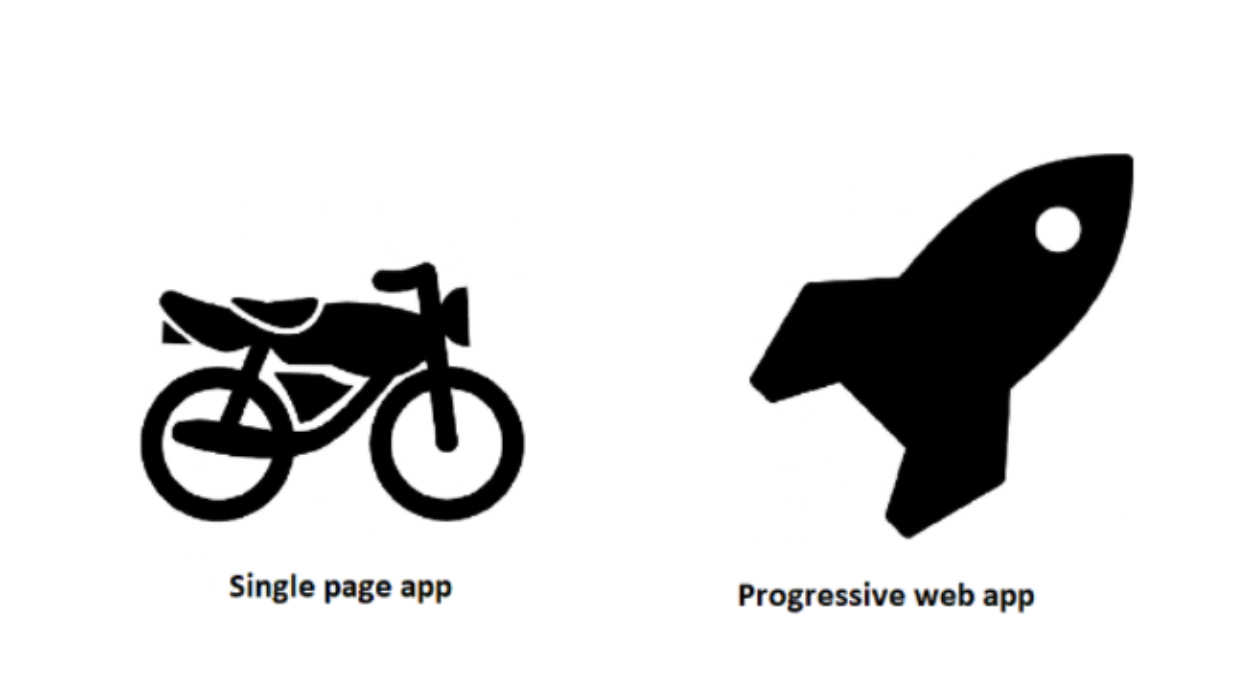The benefits of PWA vs SPA have become more and more important as the customer experience asks e-commerce providers to respond quickly and give them reliable interactions.
While a single-page application (SPA) has existed for approximately twenty years, its popularity is quite new. However, a progressive web app (PWA) is a perfect blend of SPA and PWA that brings your website the benefits of both.
In this article, we would like to give you information about the differences between single-page applications and progressive web apps to figure out which is the better one for your website. The battle between PWA vs SPA is more complex than what you imagine. Let’s take a look into each type of web application to make a comparison.
Introduction about PWA
Table of Contents
Before choosing PWA vs SPA, it is necessary to have an overview of each type of web application including definition, how to set it up as well as pros and cons to understand more about them.
About PWA
PWA is understood as a progressive web app. It is a mobile app in a browser that has gradually become an alternative to native apps. The term PWA was coined originally by Google, which established a checklist to define what creates a PWA. PWA is built from web technologies that are quite similar to us, like HTML, JavaScript, and CSS.

Progressive web app
Thanks to smart additions into its features, you can turn almost any website into PWA easily. Instead of difficulties when developing a native app, you could build a PWA rather quickly. In addition, all the features of native apps can be offered when you use PWA, like push notifications, online support, and so on.
>>> PWA vs Hyva Theme vs Vue Storefront, which one is better? DOWNLOAD our Free Handbook to find out!
How to set up a PWA?
Currently, PWA has gained popularity that brings superior web experiences. Therefore, it has gained an increase in the number of people setting up PWA. Adding the website to the home screen of a mobile device will enable users to use the website offline. Once setting up PWA, visitors are not necessary to install or download anything to use PWA’s features.
Whereas there are varieties of resources to build a simple PWA that allows you to get a feel for fulfilling the process, like Google, Microsoft, people have started questioning the ways to establish PWA in PWA Magento 2.
How does PWA work?
About the PWA performance principles, once the app is initiated, to cash the entire app wrapping, a service worker script needs to be launched. After that, when new events take place and requests are performed, content for View is loaded, and service worker will enable a sleeping mode up until the next event.
Benefits of PWA
There are many pluses of PWA, however here’s a short overview of its benefits:
- The improvement in the user experience will bring the customer an app-like feel and bridge the gap between a native app and a conventional mobile website. Take the Android operating system as an example. It gives browsers opportunities to access the hardware of mobile devices. Thanks to this opportunity, it allows features such as pushing notifications or using NFC scanning to improve CX. In addition, you can take advantage of push notifications to re-engage your users.
- The ability to save home screen or cache pages via service workers makes the website quite similar to a native app.
- The users can build PWA themselves with popular web technologies such as PWA Magento 2 at a lower price.
- PWA can work with various screen sizes but still maintain its competitive advantages as smooth, fast, and lightweight.
- Unlike other regular sites, PWA can work offline.

Benefits of PWA
Drawbacks of PWA
Besides its benefits, PWA has to face two main drawbacks:
- Platform limitations of PWA can lead to re-engagement problems.
- PWA can not be able to use the latest hardware like a fingerprint scanner. Besides, for any hardware that is not supported by HTML5, PWA does not support it.
CLICK here to find more about the Top 10 PWA’s success cases!
Introduction about SPA
Recently, we have given information about PWA. Let’s move on to the overview of SPA.
About SPA
SPA stands for a single-page application. It is a web application in which its content is dynamically loaded without reloading the page. For instance, when you check your feed on Facebook, you do not have to take time to see an aggravating page loading screen. When you scroll your feed or switch between tabs, the content is instantly loaded.
In SPA, when you open one page, all HTML and CSS are loaded instantly. Then, when you move around this site, only the updated data is loaded; the page is not necessary to reload. This is the reason why the user experience becomes smoother without wasting time waiting for loading. Currently, only a 100-millisecond lag can lead to over $1.6 million lost in sales. This is an important issue that business owners can not ignore.
How to set up a SPA?
SPA is built with JavaScript frameworks. When the developers choose the framework for SPA, they depend on many different factors, including individual preferences. There are three big JavaScript frameworks: React, Angular and Vue. However, Vue is the youngest JavaScript that is easy to learn and has more unique features than React. Soon, it is undeniable that it is a quite promising JavaScript framework developed by the community.
How does SPA work?
The whole software code will be loaded at once, with certain script files following if it is necessary, during the initialization of separate page modules. Such solutions are based on the allowance of HTML5 to store all the user activity data in the browser cache or the DOM storage.

How does SPA work?
Benefits of SPA
The benefits of SPA are numerous, which is the reason why it has become extremely popular despite several disadvantages. Now we will start with the pros of SPA.
- Switching faster and smoother between pages without actively reloading. Instead of loading all content at once, SPA has the feature of dynamic loading – loading content in small separated parts. This will shorten response time and improve the user experience.
- SPA can work offline to an extent thanks to the feature to move content processing from servers to browsers. Therefore, the browser does not need to give requests to servers and wait for responses.
- The frontend and backend are connected tightly so that you can rewrite the front end alone without or less affecting the backend.
Now, we will go on to the drawbacks.
Drawbacks of SPA
The following are the drawbacks of SPA:
- SPA is established using JavaScript. If the users are disabled in their browsers, they will see an empty page.
- Because SPA loads content via AJAX, a search bot gets a DOM (Document Object Model) element. It is a web application structure without content. Therefore there is no keyword to acquire simultaneously.
- SPA has low search engine rankings. When a site must rank high to be found by users, proper SEO is a necessity.
- SPA is not very scalable when adding novel features and new functionality for it. Because everything has been written as a single page, adding new features can disrupt its code. Therefore, the developers must be careful. In addition, too much extra code can lead your single page load to become too slow.
- SPA is susceptible to attacks from cross-site scripting (XSS). This is a minus point of SPA that permits hackers to inject malicious code into a JavaScript-based web application.
PWA vs SPA: Which one is better?
It is important to figure out the difference between PWA vs SPA to answer the question: Which one is better for your website? Now is the time to find the answer.
Loading time
In comparison, the loading time for the page, master page, and creating service worker is not as much as SPA the first time. SPA takes around 10 seconds to load. However, PWA just needs 1 second to load. The service worker is the reason why PWA has an impressive performance compared to SPA. It can help PWA render some Javascript & pre-cache many site assets, while SPA has to load these files on its own. For reloading time, while SPA needs around 5 to 10 seconds, the service worker just takes 1 second to respond. Therefore, PWA has an additional advantage here as it can work in an offline and autonomous mode.

The comparison about loading time between PWA and SPA
SEO
One of the biggest problems of using SPA that needs to be mentioned is its impact on SEO. As mentioned before, SPA uses AJAX to load content. What the search bot gets is a DOM element without content. It will negatively affect the search engine ranking of SPA. Most SPA is run on JavaScript, which is not supported by most search engines.
However, when using PWA, it can optimize SEO with server-side rendering the display on Google as well as skills for technical SEO. The server-side rendering will send a fully loaded page upon request. So, it allows crawlers to work more effectively with PWA. PWA works quite like any website. Therefore, it can be indexed in search engines. In comparison with SPA, PWA has better performance and engagement, helping your website to be ranked better in search results.
Hence, the developers usually recommend using PWA.
Improve SEO with these top 9 reliable Magento PWA providers now!
UX/UI interface
In comparison from a user experience perspective, PWA vs SPA is much more advanced than regular web applications or sites. However, PWA enables its users to load content and engageable features simultaneously, which is a bit better than SPAs.
Security
In a SPA, to keep your page safe, all you need to do is to secure data endpoints faster but not safer. SPA is more prone to be attacked by hackers as they run on JavaScript. In JavaScript, it does not perform code compilation which makes it more vulnerable to malware.
PWA is more secure than SPA as it has to run under HTTPS. Its security protocols assure that there will be no exchanges between the client and the server that are tampered with. In a secure environment provided by PWA, customers can submit their personal details as well as credit card information without the worry of stealing information.
Cost
In the aspect of building cost between PWA vs SPA, there are many factors that affect the cost such as the rate of the developer, the level of complexity of the job as well as your preferences, customizations… However, PWA comes with additional costs for establishing.
- PWAs: $2000 – $20.000
- SPAs: $1500 – $12.000

The building cost of PWA and SPA
Accessibility
From the accessibility perspective, PWA is a level above other types of solutions due to their offline interaction capacities. When it comes to the accessibility of SPA, it is actually terrible. Once executing the page transition, it tends to bring its user into the middle of nowhere. In the situation that the page continuously changes its DOM structure, it will bring the disabled feeling of frustration since there is no aria or support features for them.
With mentioned advantages, when performing a comparison between PWA vs SPA, the developers will recommend using PWA. Currently, people have started researching the ways to build PWA in PWA Magento 2.
FIND more about Magento PWA Development services here!
Conclusions
Comparison between the PWA vs SPA shows that both of them are highly efficient options for developers and users. The ultimate choice relies on project requirements, goals, as well as your capacities. However, PWA is better than SPA in several perspectives when building your website.
BSS Commerce is one of the top Multi-platform eCommerce solutions and web development services providers all over the world. With experienced developers in this field, we commit to bringing our customers high-quality products and services to optimize your business effectively.
CONTACT NOW to let us know your problems. We are willing to support you every time.

